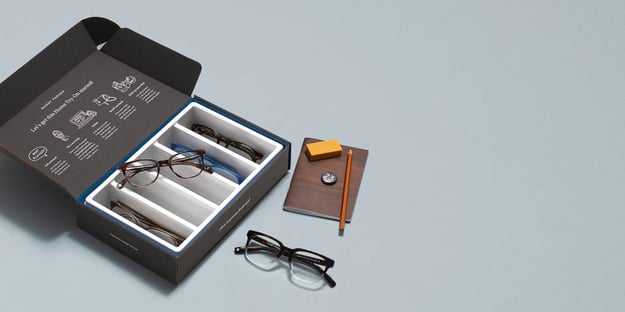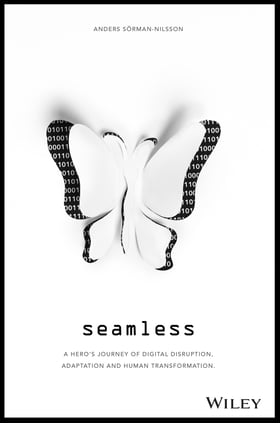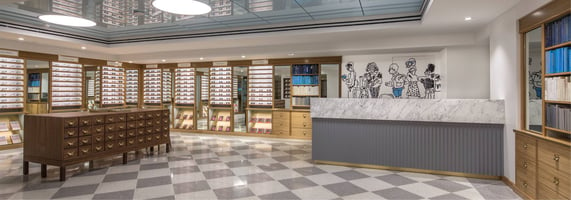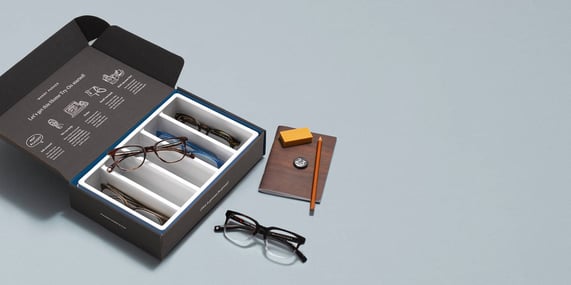Foresights and ideas that expand minds and inspire a change of heart.

How do you identify industries that are too safe in their ‘ordinary world’ and are sticking too rigidly with their status quo? In other, words what industries are ready for disruption? No easy answers to this question exist, but three general signals do indicate if a market is likely to be disrupted:

This case study is featured in my upcoming book, Seamless: A Hero's Journey of Digital Disruption, Adaptation and Human Transformation, which is due for release in February 2017.
"When the unstoppable force of Anders' furious futurist's intellect crashes into the immovable object of his mother's sense of family and traditions sparks fly. Our hero's journey turns out to be anything but seamless. It holds lessons for all of us pushing the digital envelope in a persistently analogue world."

Inside Warby Parker's store at Grand Central in New York. Image from warbyparker.com
First of all, if an industry is dominated by a few big organisations that are self-satisfied, you can anticipate that disruption is near. And, secondly, industries that are experiencing recurring customer friction and frustration (think the insurance industry and consumer banking) are also under risk of being disrupted because customers will eventually start looking for other alternatives. This will, in turn, create a breeding ground for creative entrepreneurs who are willing to invest their time and energy into finding solutions that effectively address the real issues. (For more information on this, see Anna Johansson’s article ’Shake it up: How to identify industries that are ready for disruption’, available on Business.com.)
The third sign that an industry might face disruption is when intermediaries are interchangeable or don’t add value. The kind of professionals I’m referring to here include travel agents, stock brokers, real estate brokers and photographer’s agents. Digitisation has affected all of these sectors and more or less dramatically changed the relationship between the seller and the buyer.
All of these signs were in one sense or the other visible when Neil Blumenthal, now CEO of renowned eyewear company Warby Parker, started his business in 2010 (together with his MBA classmates Dave Gilboa, Andrew Hunt and Jeffrey Raider at University of Pennsylvania’s Wharton School). Just like many other successful entrepreneurs, they started with identifying a problem — in this case, the problem they identified was simply that they thought glasses were too expensive.
When Blumenthal and his fellow entrepreneurs began their deep dive into the industry, they realised that the whole infrastructure behind the manufacturing of glasses was owned by a single company. As is common in industries dominated by a few very large players, they also saw rising prices for consumers and mediocre customer experiences.
And in 2009 and 2010, before they launched their business, they found out that less than 1 per cent of glasses were sold online while in other consumer goods categories online sales represented 10 and 15 per cent of the total market. It was out of these insights that the founders came to the conclusion that an entrepreneurial opportunity existed to reinvent the eyewear market.
Another insight they gained from talking to friends about their project in 2009 and 2010 was that people still were very hesitant about buying eyewear online, mainly because they couldn’t see how the glasses would look on their face. To tackle this barrier Warby Parker first decided to offer free shipping and free returns. However, they thought that this offer wasn’t enough to fundamentally solve the problem, so they decided to launch Virtual Booth, which is a feature that enables you to upload a picture on the website and then virtually try out different frames to see how they look on you.
Although the founders were happy with this solution, they were not completely satisfied, and they still asked themselves whether they would buy using this tool. After some time the founders came up with the additional idea of launching ‘Home Try-On’. The idea behind this was simple: select five frames that you would like to try and keep them for five days. Then simply return the frames you don’t want. Warby Parker pays for both shipping and return shipping, with no obligation to buy. The combination of free shipping and free returns, the Virtual Booth and the Home Try-On service not only helped customers to seamlessly overcome barriers and reduce pain points, but also elevated the whole shopping experience.

With Warby Parker's home try-on you can select 5 frames to test out for five days. Image from warbyparker.com
WarbyParker.com went live on February 2015 and two days later was featured in the renowned men’s fashion magazine GQ, which called them ‘the Netflix of eyewear’. During the same month they were also featured in Vogue. The publicity helped raise brand awareness and boosted their sales to such an extent that they reached their first year sales target within three weeks, and as a result had to manage a waiting list of 20,000 people.
Of course, keeping so many impatient people happy was a challenge, but they successfully managed this by being transparent about the delay in shipments and also explaining to customers what was going on. And, since then Warby Parker has heavily invested in seamless customer service and ensured that they hire people that are genuinely friendly and can deliver the kind of deep empathy that the founders wanted the brand to communicate.
An essential part of the brand’s identity is their social mission, which is communicated under the slogan ‘Buy a pair, give a pair’ — and you can read more about the logistics and results of this promise on warbyparker.com. A company’s social mission might not be the most important factor for consumers, but research from the global performance management company Nielsen suggests that consumers are increasingly willing to vote with their dollars. Consumers among the generational cohort Generation Y or Millennials are especially willing to pay more for products and services from companies committed to social responsibility. (See the article ‘Global consumers are willing to put their money where their heart is when it comes to goods and services from companies committed to social responsibility’)
Watch this video where the founders speak about "Buy a pair, give a pair".
Another great benefit of having a social mission, according to Blumenthal, is that you attract people with the right skill set and, maybe even more importantly, with values that are aligned with your corporate culture. What’s key here is that Warby Parker’s social mission is seamlessly integrated with the brand and not just an ‘add-on’, thus making their commitment more credible and trustworthy. Another lesson you can take away from their way of working with a social mission is that they are making it easy for consumers to contribute to a better world. They’re not demanding anything from their customers, but instead making every purchase a seamless act of kindness.
In the process, Warby Parker, of course, represents a problem in the extraordinary world of the future of retail that is severely encroaching on the ordinary world of the incumbents.
Think about the following to get some ideas on how you can apply the insights from Warby Parker to your business:
Do any signs indicate that your industry might be disrupted in the near future? How can you turn those future challenges into opportunities?
What assumptions about your industry (and your ordinary world) are you accepting without critical thought? Think about how you can question the status quo in your industry and create more value for your customers.
What problems and barriers might hinder or impede your customers from doing business with you? How can you turn these insights into creative ideas and solutions?
What sort of combination of different solutions collectively could address different aspects of a problem?
What do you do in order to ensure that the customer service that your business offers is top of the line? How can you better incorporate your brand values into your customer service?
What would a social mission look like for your company? How can you tie this mission to the core of your brand and make it seem credible to your stakeholders, allies, and fellowship?
How can your products and/or services seamlessly contribute to a more sustainable society in an extraordinary world?
This case study is featured in my upcoming book, Seamless: A Hero's Journey of Digital Disruption, Adaptation and Human Transformation, which is due for release in February 2017.

Header Text
Lorem ipsum dolor sit amet, consectetur adipiscing elit, sed do eiusmod tempor incididunt ut labore et dolore magna aliqua. Ut enim ad minim veniam, quis nostrud exercitation ullamco laboris nisi ut aliquip ex ea commodo consequat. Duis aute irure dolor in reprehenderit in voluptate velit esse cillum dolore eu fugiat nulla pariatur.
Lorem ipsum dolor sit amet, consectetur adipiscing elit, sed do eiusmod tempor incididunt ut labore et dolore magna aliqua. Ut enim ad minim veniam, quis nostrud exercitation ullamco laboris nisi ut aliquip ex ea commodo consequat. Duis aute irure dolor in reprehenderit in voluptate velit esse cillum dolore eu fugiat nulla pariatur.
Lorem ipsum dolor sit amet, consectetur adipiscing elit, sed do eiusmod tempor incididunt ut labore et dolore magna aliqua. Ut enim ad minim veniam, quis nostrud exercitation ullamco laboris nisi ut aliquip ex ea commodo consequat. Duis aute irure dolor in reprehenderit in voluptate velit esse cillum dolore eu fugiat nulla pariatur.

Header Text
Lorem ipsum dolor sit amet, consectetur adipiscing elit, sed do eiusmod tempor incididunt ut labore et dolore magna aliqua. Ut enim ad minim veniam, quis nostrud exercitation ullamco laboris nisi ut aliquip ex ea commodo consequat. Duis aute irure dolor in reprehenderit in voluptate velit esse cillum dolore eu fugiat nulla pariatur.
Lorem ipsum dolor sit amet, consectetur adipiscing elit, sed do eiusmod tempor incididunt ut labore et dolore magna aliqua. Ut enim ad minim veniam, quis nostrud exercitation ullamco laboris nisi ut aliquip ex ea commodo consequat. Duis aute irure dolor in reprehenderit in voluptate velit esse cillum dolore eu fugiat nulla pariatur.
Lorem ipsum dolor sit amet, consectetur adipiscing elit, sed do eiusmod tempor incididunt ut labore et dolore magna aliqua. Ut enim ad minim veniam, quis nostrud exercitation ullamco laboris nisi ut aliquip ex ea commodo consequat. Duis aute irure dolor in reprehenderit in voluptate velit esse cillum dolore eu fugiat nulla pariatur.

Header Text
Lorem ipsum dolor sit amet, consectetur adipiscing elit, sed do eiusmod tempor incididunt ut labore et dolore magna aliqua. Ut enim ad minim veniam, quis nostrud exercitation ullamco laboris nisi ut aliquip ex ea commodo consequat. Duis aute irure dolor in reprehenderit in voluptate velit esse cillum dolore eu fugiat nulla pariatur.
Lorem ipsum dolor sit amet, consectetur adipiscing elit, sed do eiusmod tempor incididunt ut labore et dolore magna aliqua. Ut enim ad minim veniam, quis nostrud exercitation ullamco laboris nisi ut aliquip ex ea commodo consequat. Duis aute irure dolor in reprehenderit in voluptate velit esse cillum dolore eu fugiat nulla pariatur.
Lorem ipsum dolor sit amet, consectetur adipiscing elit, sed do eiusmod tempor incididunt ut labore et dolore magna aliqua. Ut enim ad minim veniam, quis nostrud exercitation ullamco laboris nisi ut aliquip ex ea commodo consequat. Duis aute irure dolor in reprehenderit in voluptate velit esse cillum dolore eu fugiat nulla pariatur.
& STAY UP TO DATE WITH FORESIGHTS AND TREND REPORTS!
WE WILL EQUIP YOU WITH THE VIDEOS AND MATERIALS YOU NEED TO SUCCESSFULLY PITCH ASN.
0 Comment